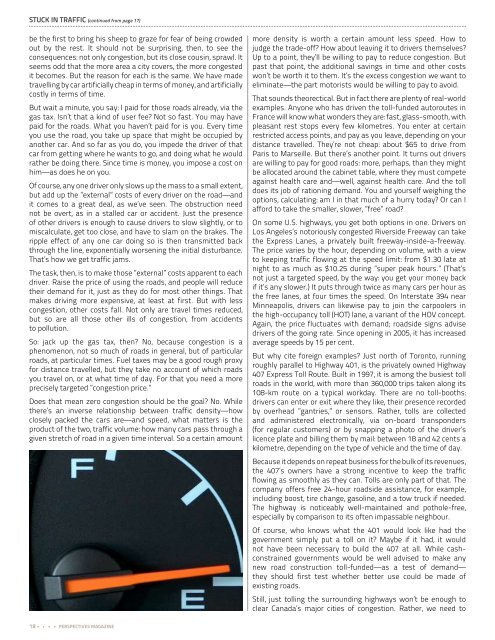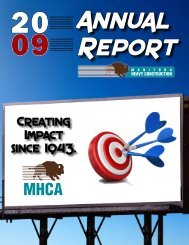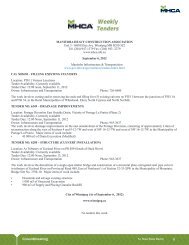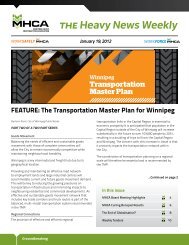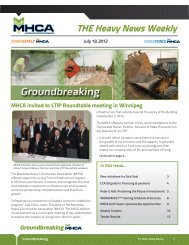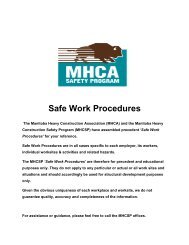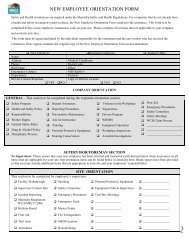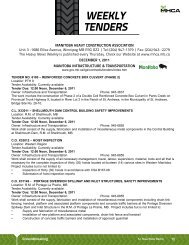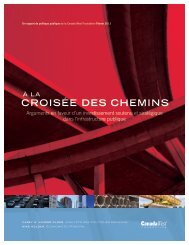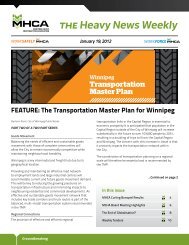2012 Perspectives Magazine - Manitoba Heavy Construction ...
2012 Perspectives Magazine - Manitoba Heavy Construction ...
2012 Perspectives Magazine - Manitoba Heavy Construction ...
Create successful ePaper yourself
Turn your PDF publications into a flip-book with our unique Google optimized e-Paper software.
Stuck in Traffic (continued from page 17)<br />
be the first to bring his sheep to graze for fear of being crowded<br />
out by the rest. It should not be surprising, then, to see the<br />
consequences: not only congestion, but its close cousin, sprawl. It<br />
seems odd that the more area a city covers, the more congested<br />
it becomes. But the reason for each is the same. We have made<br />
travelling by car artificially cheap in terms of money, and artificially<br />
costly in terms of time.<br />
But wait a minute, you say: I paid for those roads already, via the<br />
gas tax. Isn’t that a kind of user fee? Not so fast. You may have<br />
paid for the roads. What you haven’t paid for is you. Every time<br />
you use the road, you take up space that might be occupied by<br />
another car. And so far as you do, you impede the driver of that<br />
car from getting where he wants to go, and doing what he would<br />
rather be doing there. Since time is money, you impose a cost on<br />
him—as does he on you.<br />
Of course, any one driver only slows up the mass to a small extent,<br />
but add up the ”external” costs of every driver on the road—and<br />
it comes to a great deal, as we’ve seen. The obstruction need<br />
not be overt, as in a stalled car or accident. Just the presence<br />
of other drivers is enough to cause drivers to slow slightly, or to<br />
miscalculate, get too close, and have to slam on the brakes. The<br />
ripple effect of any one car doing so is then transmitted back<br />
through the line, exponentially worsening the initial disturbance.<br />
That’s how we get traffic jams.<br />
The task, then, is to make those ”external” costs apparent to each<br />
driver. Raise the price of using the roads, and people will reduce<br />
their demand for it, just as they do for most other things. That<br />
makes driving more expensive, at least at first. But with less<br />
congestion, other costs fall. Not only are travel times reduced,<br />
but so are all those other ills of congestion, from accidents<br />
to pollution.<br />
So: jack up the gas tax, then? No, because congestion is a<br />
phenomenon, not so much of roads in general, but of particular<br />
roads, at particular times. Fuel taxes may be a good rough proxy<br />
for distance travelled, but they take no account of which roads<br />
you travel on, or at what time of day. For that you need a more<br />
precisely targeted ”congestion price.”<br />
Does that mean zero congestion should be the goal? No. While<br />
there’s an inverse relationship between traffic density—how<br />
closely packed the cars are—and speed, what matters is the<br />
product of the two, traffic volume: how many cars pass through a<br />
given stretch of road in a given time interval. So a certain amount<br />
more density is worth a certain amount less speed. How to<br />
judge the trade-off? How about leaving it to drivers themselves?<br />
Up to a point, they’ll be willing to pay to reduce congestion. But<br />
past that point, the additional savings in time and other costs<br />
won’t be worth it to them. It’s the excess congestion we want to<br />
eliminate—the part motorists would be willing to pay to avoid.<br />
That sounds theorectical. But in fact there are plenty of real-world<br />
examples. Anyone who has driven the toll-funded autoroutes in<br />
France will know what wonders they are: fast, glass-smooth, with<br />
pleasant rest stops every few kilometres. You enter at certain<br />
restricted access points, and pay as you leave, depending on your<br />
distance travelled. They’re not cheap: about $65 to drive from<br />
Paris to Marseille. But there’s another point. It turns out drivers<br />
are willing to pay for good roads: more, perhaps, than they might<br />
be allocated around the cabinet table, where they must compete<br />
against health care and—well, against health care. And the toll<br />
does its job of rationing demand. You and yourself weighing the<br />
options, calculating: am I in that much of a hurry today? Or can I<br />
afford to take the smaller, slower, ”free” road?<br />
On some U.S. highways, you get both options in one. Drivers on<br />
Los Angeles’s notoriously congested Riverside Freeway can take<br />
the Express Lanes, a privately built freeway-inside-a-freeway.<br />
The price varies by the hour, depending on volume, with a view<br />
to keeping traffic flowing at the speed limit: from $1.30 late at<br />
night to as much as $10.25 during ”super peak hours.” (That’s<br />
not just a targeted speed, by the way: you get your money back<br />
if it’s any slower.) It puts through twice as many cars per hour as<br />
the free lanes, at four times the speed. On Interstate 394 near<br />
Minneapolis, drivers can likewise pay to join the carpoolers in<br />
the high-occupancy toll (HOT) lane, a variant of the HOV concept.<br />
Again, the price fluctuates with demand; roadside signs advise<br />
drivers of the going rate. Since opening in 2005, it has increased<br />
average speeds by 15 per cent.<br />
But why cite foreign examples? Just north of Toronto, running<br />
roughly parallel to Highway 401, is the privately owned Highway<br />
407 Express Toll Route. Built in 1997, it is among the busiest toll<br />
roads in the world, with more than 360,000 trips taken along its<br />
108-km route on a typical workday. There are no toll-booths:<br />
drivers can enter or exit where they like, their presence recorded<br />
by overhead ”gantries,” or sensors. Rather, tolls are collected<br />
and administered electronically, via on-board transponders<br />
(for regular customers) or by snapping a photo of the driver’s<br />
licence plate and billing them by mail: between 18 and 42 cents a<br />
kilometre, depending on the type of vehicle and the time of day.<br />
Because it depends on repeat business for the bulk of its revenues,<br />
the 407’s owners have a strong incentive to keep the traffic<br />
flowing as smoothly as they can. Tolls are only part of that. The<br />
company offers free 24-hour roadside assistance, for example,<br />
including boost, tire change, gasoline, and a tow truck if needed.<br />
The highway is noticeably well-maintained and pothole-free,<br />
especially by comparison to its often impassable neighbour.<br />
Of course, who knows what the 401 would look like had the<br />
government simply put a toll on it? Maybe if it had, it would<br />
not have been necessary to build the 407 at all. While cashconstrained<br />
governments would be well advised to make any<br />
new road construction toll-funded—as a test of demand—<br />
they should first test whether better use could be made of<br />
existing roads.<br />
Still, just tolling the surrounding highways won’t be enough to<br />
clear Canada’s major cities of congestion. Rather, we need to<br />
18 perspectives <strong>Magazine</strong>


